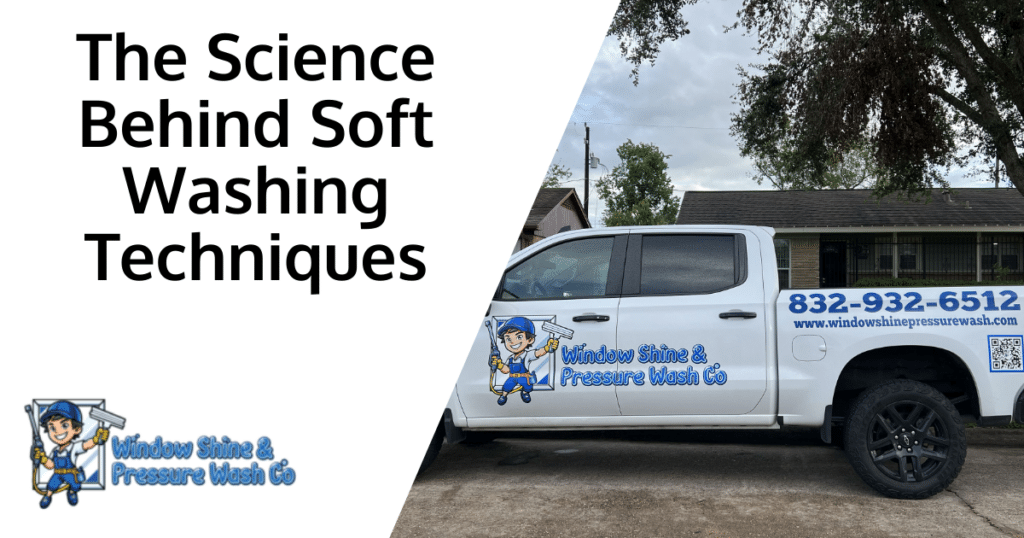- What new trends are emerging in the soft washing industry?
- How are advancements in technology impacting soft washing?
Understanding Soft Washing Techniques
Modern cleaning methods have come a long way from the traditional use of buckets, mop, and scrubbing brushes. One effective option widely adopted is soft washing.
What is Soft Washing?
Soft washing is an innovative cleaning process that employs low-pressure water flow and specially formulated washing solutions to clean and maintain surfaces. Unlike high-pressure washing or power washing that relies solely on the high pressure of water to remove dirt, soft wash instead concentrates on the cleaning solution’s ability to break down dirt particles and kill bacteria.
- Soft washing’s methodology revolves around the use of precise mixtures of quality cleansing solutions applied at low pressure. These solutions then do the heavy lifting of cleaning, debris removal, and even treatment of certain organic growth conditions.
- Soft washing is highly recommended for delicate surfaces where traditional pressure washing could damage the material, including wooden decks, roof shingles, or painted surfaces. The primary reason for this is that soft washing eliminates the risks of surface damage due to excessive pressure.
- The secret to soft washing’s effectiveness lies in its chemical solutions. These solutions are often composed of mildewcides, algae removers, soaps, and surfactants. The chemistry involved works to remove contaminants at their source for longer-lasting cleanliness.
The Benefits of Soft Washing
The benefits of soft washing are multi-fold, combining surface treatment, enhanced aesthetic appeal, and environmental sustainability.
- Soft washing offers a wealth of advantages, paramount being its gentle yet effective approach to exterior cleaning. It’s a safe, non-invasive procedure that cleans without the risk of destruction associated with high-pressure alternatives.
- More than just surface cleaning, soft washing aids in maintaining the integrity of surfaces. By removing harmful substances like mold or algae, it contributes to the increased lifespan of the material being cleaned.
- From an environmental standpoint, soft washing is commendable as well. The process uses less water compared to high-pressure washing and, with eco-friendly cleaning solutions, ensures minimal environmental impact.
Components and Chemicals Used in Soft Washing
Key Chemicals in Soft Washing Solutions
The success of soft washing is largely dependent on the chemical solutions used. These solutions are prepared with specific chemicals that aid in surface cleaning and treatment.
- Typical soft washing solutions may contain a variety of chemicals, including sodium hypochlorite, surfactants, mildewcides, and water. Each of these ingredients plays a pivotal role in the cleaning action, with sodium hypochlorite serving as a disinfectant, surfactants aiding in dirt and grime removal, and mildewcides preventing the regrowth of mold and mildew.
- These chemicals act collaboratively in soft washing solutions to break down organic matter, remove contaminants, and maintain surface cleanliness for an extended period.
Safety Considerations When Using Soft Washing Chemicals
While soft washing chemicals are effective in their job, it’s important to handle them safely to prevent any harm.
- When handling soft washing solutions, wearing protective gear such as gloves and goggles is essential to prevent direct contact with skin or eyes. Ventilation is crucial when preparing solutions, and care should be taken to avoid spillage or mixing incompatible chemicals.
- From a safety perspective, some chemicals in soft washing solutions could be corrosive or toxic. Therefore, understanding the safety instructions and proper handling is crucial to prevent potential hazards.
Techniques and Applications of Soft Washing
Soft Washing Techniques for Different Surfaces
Soft Washing techniques can be optimized for diverse types of surfaces, each requiring a unique approach.
- Soft washing techniques differ for various surface types. For instance, cleaning a wooden deck would need a different approach to a concrete driveway or a painted wall. Considering the surface material when soft washing ensures effective cleaning without causing any unintentional damage.
- Delicate surfaces such as roof shingles require particular attention during soft washing. For these surfaces, a softer spray and more diluted solution are often used to prevent damage, yet remove growths and dirt successfully.
DIY Soft Washing vs. Professional Services
Deciding between DIY and hiring professional services can depend on factors such as the complexity of the task, available equipment, and desired results.
- DIY soft washing can be an economical option for small-scale cleaning tasks. However, it may not always provide the desired results due to a lack of professional equipment and expertise.
- In contrast, hiring professional services may be beneficial where complex or large-scale cleaning is required. Professional services often bring a wealth of experience and industrial-grade equipment to the table, ensuring an effective and thorough cleaning job.
Challenges and Trends in Soft Washing
Common Challenges in Soft Washing
Though a highly effective cleaning method, soft washing does come with its share of challenges.
- Common challenges encountered during soft washing include selecting the right chemical mix, ensuring safety when handling chemicals, and using the correct pressure. These challenges can be effectively addressed by following best practices, wearing appropriate safety gear, and gaining the necessary knowledge or training.
- By overcoming these challenges, one can unlock the full potential of soft washing as a reliable and effective cleaning regime.
Emerging Trends in Soft Washing
Innovation and technology are driving new trends in the soft washing industry, further advancing its effectiveness and reach.
- In recent years, trends in soft washing are increasingly geared towards even gentler and more eco-friendly solutions. Advances in technology are also lending to the development of more efficient cleaning equipment and processes.
- Technological shifts continue to shape the realm of soft washing, influencing cleaning methods and standards to ensure safer, effective, and more sustainable outcomes.

